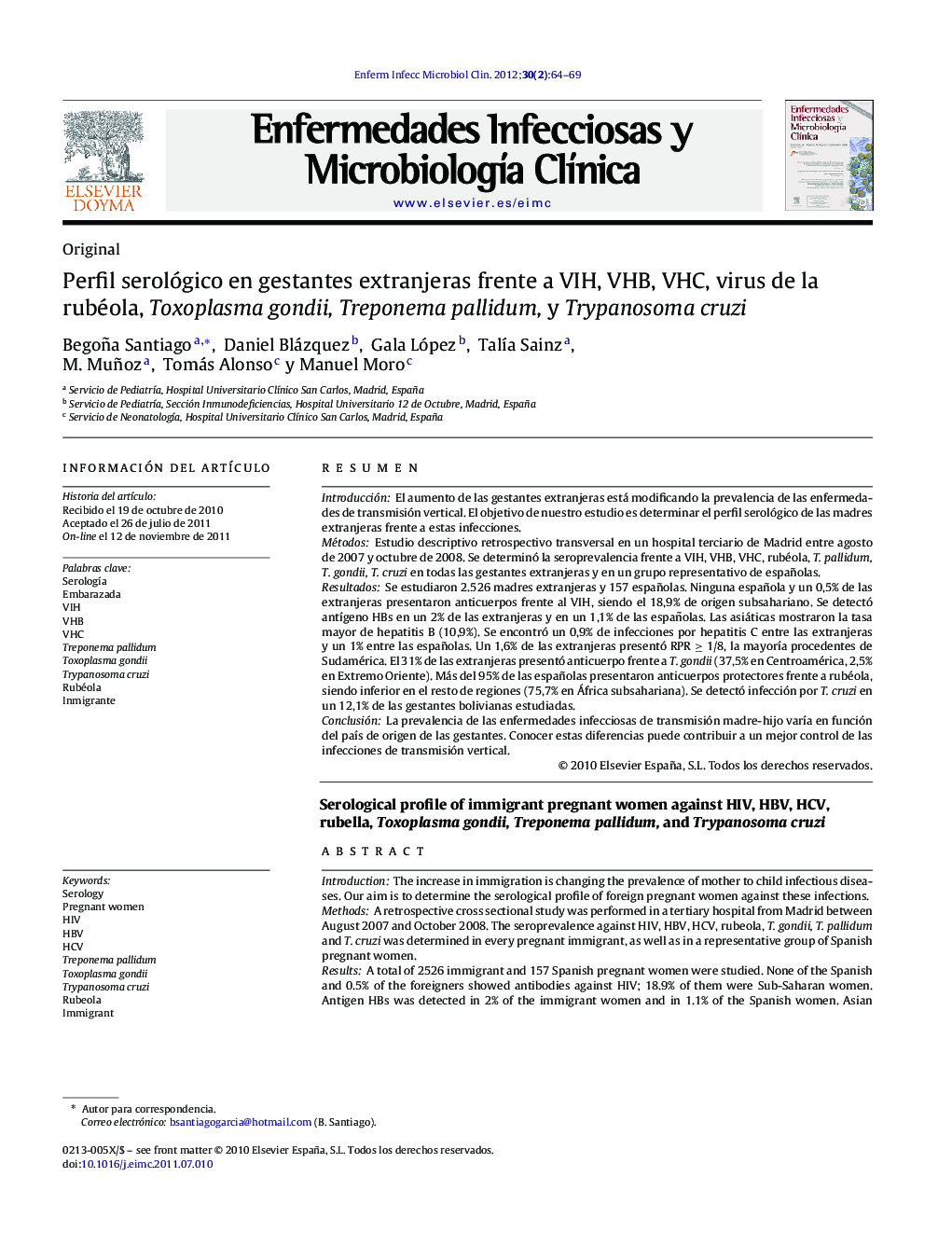| Article ID | Journal | Published Year | Pages | File Type |
|---|---|---|---|---|
| 3401480 | Enfermedades Infecciosas y Microbiología Clínica | 2012 | 6 Pages |
ResumenIntroducciónEl aumento de las gestantes extranjeras está modificando la prevalencia de las enfermedades de transmisión vertical. El objetivo de nuestro estudio es determinar el perfil serológico de las madres extranjeras frente a estas infecciones.MétodosEstudio descriptivo retrospectivo transversal en un hospital terciario de Madrid entre agosto de 2007 y octubre de 2008. Se determinó la seroprevalencia frente a VIH, VHB, VHC, rubéola, T. pallidum, T. gondii, T. cruzi en todas las gestantes extranjeras y en un grupo representativo de españolas.ResultadosSe estudiaron 2.526 madres extranjeras y 157 españolas. Ninguna española y un 0,5% de las extranjeras presentaron anticuerpos frente al VIH, siendo el 18,9% de origen subsahariano. Se detectó antígeno HBs en un 2% de las extranjeras y en un 1,1% de las españolas. Las asiáticas mostraron la tasa mayor de hepatitis B (10,9%). Se encontró un 0,9% de infecciones por hepatitis C entre las extranjeras y un 1% entre las españolas. Un 1,6% de las extranjeras presentó RPR ≥ 1/8, la mayoría procedentes de Sudamérica. El 31% de las extranjeras presentó anticuerpo frente a T. gondii (37,5% en Centroamérica, 2,5% en Extremo Oriente). Más del 95% de las españolas presentaron anticuerpos protectores frente a rubéola, siendo inferior en el resto de regiones (75,7% en África subsahariana). Se detectó infección por T. cruzi en un 12,1% de las gestantes bolivianas estudiadas.ConclusiónLa prevalencia de las enfermedades infecciosas de transmisión madre-hijo varía en función del país de origen de las gestantes. Conocer estas diferencias puede contribuir a un mejor control de las infecciones de transmisión vertical.
IntroductionThe increase in immigration is changing the prevalence of mother to child infectious diseases. Our aim is to determine the serological profile of foreign pregnant women against these infections.MethodsA retrospective cross sectional study was performed in a tertiary hospital from Madrid between August 2007 and October 2008. The seroprevalence against HIV, HBV, HCV, rubeola, T. gondii, T. pallidum and T. cruzi was determined in every pregnant immigrant, as well as in a representative group of Spanish pregnant women.ResultsA total of 2526 immigrant and 157 Spanish pregnant women were studied. None of the Spanish and 0.5% of the foreigners showed antibodies against HIV; 18.9% of them were Sub-Saharan women. Antigen HBs was detected in 2% of the immigrant women and in 1.1% of the Spanish women. Asian women had the highest rate of type B Hepatitis (10.9%). There was 0.9% of type C Hepatitis among the immigrants and 1% among the Spanish. Within the cases with RPR ≥ 1/8, 1.6% were immigrants, most of whom were Latin American. Thirty-one per cent of the immigrants showed antibodies against T. gondii (37.5% from Central America, 2.5% from the Far East). More than 95% of the Spanish women had antibodies against Rubella, this being lower in the rest of the areas (75.5% in Sub-Saharan Africa). T. cruzi infection was detected in 12.1% of the Bolivian women studied.ConclusionThe prevalence of mother-to-child transmitted infections depends on the origin of pregnant women. Knowledge of these differences may lead to improved control these diseases.
